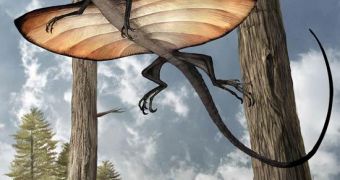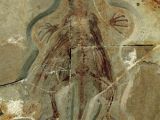Scientists have recently discovered a lizard shockingly similar to current flying dragons roaming the air during the dinosaur era.
Exactly like in the flying dragons, the ancient arboreal lizard presents a wing-like membrane stretched across elongated ribs. Named Xianglong zhaoi, the gliding lizard lived during the Early Cretaceous (last dinosaur era) period, about 125 million years ago.
The specimen measures 6 inches (15.5 centimeters) long, with a slender 9.5 (3.8 inches) tail and its immature traits point to the fact that it was a juvenile.
The fossil was discovered by Xing Xu at the Institute of Vertebrate Paleontology and Paleoanthropology in Beijing, China and his team in northeastern China's Liaoning Province, a site that has delivered a trove of feathered dinosaurs and early bird remains during the last years.
Xianglong's gliding membrane (patagium) stretches across eight elongated dorsal ribs and when fully expanded, it would have spanned about 4.5 inches (11 centimeters). The fossil's membrane is in a half-open position, due to the folding of the wing after the lizard's death.
Xianglong presents curved claws, probably used to climb to treetops, from whose high perch it could launch into the air, gliding to catch insects. "Once airborne, the little lizard could probably glide farther than modern flying lizards, perhaps as far as half a football field at a time," Xu said.
The lizard's patagium shares some similarities with the wings of modern birds, indicating it was somehow more agile in the air than modern flying dragons are (but still, not as agile as a bird).
Most gliding animals, such as "flying" frogs, geckos, sugar gliders, colugos, and squirrels, employ a membrane spreading between their toes or between their body and legs to stay airborne, but without inner bony support.
But a gliding membrane spread between elongated ribs was only found in an ancient lizard-like reptile, Coelurosauravus, from German Permian (300 million years ago), the ancient lizards Icarosaurus and Kuehneosaurus that lived in Europe and North America during the Late Triassic (the first dinosaur era), about 200 million years ago (thus much earlier than Xianglong) and modern flying dragon lizards in Southeast Asia. "It is really amazing to see evolution making nearly identical structures in animals of different origins spanning such a long history," Xu told LiveScience.
"This is also the first fossil evidence that unequivocally demonstrates an impression of the skin around the edge of the ribcage", said Sankar Chatterjee, a palaeontologist at Texas Tech University in Lubbock, US.
Scientists warn that Xianglong is not the ancestor of the flying dragons, which are related to other modern dragon lizards.

 14 DAY TRIAL //
14 DAY TRIAL // 
